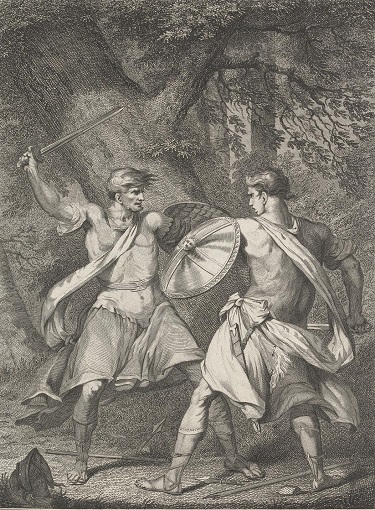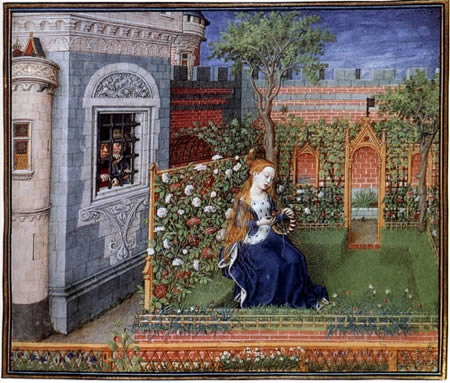
In his various works, it is very common for Geoffrey Chaucer to adopt and adapt the stories and characters of others into his own narratives. In fact, many times, Chaucer uses the exact same characters and stories of famous authors such as Virgil, Homer and Dante in his own texts. Yet, it is rare for Chaucer to put in the center of two of his stories the same character he borrows from another writer and to portray this character completely differently in each story.
Such is the case of Arcita, a character that Chaucer takes from Giovanni Boccaccio’s Teseida and characterizes in an entirely opposite manner in two of his texts: Anelida and Arcite and in The Knight’s Tale from The Canterbury Tales. This essay will compare and discuss the varied adaptations of Arcita into Chaucer’s texts.
In Anelida and Arcite, as Walter Skeat denotes (Oxford: 1894–1897, Volume I, p. 77), Chaucer utilizes only the basic figure of Arcita (Arcite) and solely the general context from Boccaccio’s Teseida, while it seems that the narrative time of Anelida and Arcite precedes most of that of the Teseida, as the two stories merely slightly coincide. Whereas in the Teseida, the Athenian hero Theseus (Teseo) leads his army to Thebes, where he captures Arcita and his cousin Palamon (book II) after finishing a successful campaign against the Amazons of Scythia (book I), the brief plot of Anelida and Arcite is set right between these two events – when Theseus still celebrates his victory over Scythia (lines 22-42). Chaucer, however, rewrites the plot of the Teseida in The Knight’s Tale almost in its entirety and remains faithful to the source with only relatively minor alterations, which will be later discussed.
Thus, the differences in the characteristics of Arcita between the Teseida and Anelida and Arcite will be first analyzed; and second, the several modifications that Chaucer made to Boccaccio’s Arcita in The Knight’s Tale will be elaborated.
The Many Vices of Anelida and Arcite‘s Arcita
The first conspicuous variation in the treatment of Arcita in Anelida and Arcite compared to the Teseida is the narrator’s regard and attitude toward him. While in the Teseida, the omniscient narrator plainly retells the story dryly and does not express his own personal opinion of Arcita, the unknown third-person narrator in Anelida and Arcite is entirely judgmental and biased against him from the very beginning. Chaucer’s narrator refers to Arcita as “fals” already during the first time that he mentions him (line 11) and continues to do so ten more times throughout the poem (lines 49, 97, 140, 141, 149, 151, 155, 156, 168 and 198); in addition, the narrator calls Arcita “this theef” (line 161), independently determines that what he did was “traitorye” (line 156) and angrily states that he “did [Anelida] al this tene” (line 168). The depiction of Arcita in Anelida and Arcite is therefore inherently much more unfavorable than in the Teseida from the governing point of view of the narrator himself.
While the narrator in Anelida and Arcite is clearly prejudicial, there are yet innate negative characteristics of Arcita that Chaucer ascribes to him directly, which are actually in complete opposition to Arcita’s characteristics in Boccaccio’s Teseida. One fundamental contradiction in Arcita’s personality between the two texts is his unfaithfulness in Chaucer’s poem versus his utter loyalty in Boccaccio’s.
In the Teseida, years after Arcita last saw Emilia, he still remains devoted to her, even without never actualizing his love, and decides to return to Athens where he might face death (book IV); there, he ultimately reencounters his cousin Palamon, and by Theseus’s order he waits another full year just to fight Palamon for the possibility of marrying Emilia (book V-VI). As opposed to Boccaccio’s totally committed Arcita, Chaucer’s Arcita is erratic and adulterous. In Anelida and Arcite, Arcita sees the beautiful queen Anelida and “with his cunning wan this lady bright” (line 89), but not so long after, he begins an affair with “another lady, proud and newe” (line 144) and thus “falsed fair Anelida the quene” (line 147); even after Arcita makes Anelida suffer, he does not care if she would “flete or sinke” (line 182).

Chaucer turns Arcita into a cheating philanderer and thus fully inverts Arcita’s trait of absolute fidelity as it is evidently embodied in Boccaccio’s Arcita.
In addition to Arcita’s prominent unfaithful nature in Anelida and Arcite, Chaucer adds other vices to Arcita that do not exist at all in Boccaccio’s Teseida. Arcita’s portrayal in the Teseida is undoubtedly sincere and true to Emilia from the first time that he sees her – he hears her singing, and after watching her, he tells himself that she is from paradise and even compares her to Venus (book III). At the first time that he sees Anelida, Chaucer’s Arcita is distinguished as a deceitful womanizer: the narrator recounts that “he was double in love … / And subtil in that crafte over any wight” (lines 87-88).
Arcita’s deceitfulness in Anelida and Arcite is further emphasized when “[w]ithouten love he feyned Ielosye” (line 126) to Anelida and later on “he bar hir on honde of trecherye” just so he could “covere his traitorye” (lines 156-158). Not only that he cruelly deceives Anelida, but Arcita also appears utterly emotionless and apathetic to Anelida’s misery that he himself inflicts, which is perhaps best expressed by Anelida herself in her “compleynt.” Among other grievances, Anelida alleges that “of [her] wo he is so routheles” (line 230) and that Arcita even “laugheth at [her] peyne” (line 234).
Even though Emilia does express her desire not to marry anyone and to remain a maiden forever (book VII), such personal accusations are never mentioned in Boccaccio’s Teseida. Hence, as opposed to the generally chivalric portrait of Arcita in the Teseida, he is rendered as deceptive, cruel and callous in Anelida and Arcite.
Loyal Adaptation of Boccaccio’s Teseida in Chaucer’s The Knight’s Tale
Whereas the character of Arcita is completely different between Boccaccio’s Teseida and Chaucer’s Anelida and Arcite, Chaucer loyally adopts almost in full Boccaccio’s entire story – with the more sympathetic representation of Arcita – in The Knight’s Tale. However, there are yet several differences between the two texts regarding Arcita specifically and the story as a whole.
While in the Teseida, it is Arcita who first sees Emilia after hearing her singing and then calls Palamon to see her as well, in The Knight’s Tale, it is Palamon who first “cast his eye upon Emelya” (line 219) and then tells about it to Arcita. This switch allows Chaucer to create a humorous quarrel between the two cousins in which Palamon grotesquely argues that he is the one who should be with Emilia because he “loved hire first” (line 287), to which Arcita facetiously replies that what Palamon experiences “is affeccioun of hoolynesse, / And myn is love, as to a creature” (lines 300-301). Chaucer thus adds a comical aspect to the cousins’ dispute and also chooses to depict the characters more ludicrously than in the Teseida.
Another similar instance in which Chaucer hyperbolizes Boccaccio’s story and characters is the moment of separation of Arcita and Palamon when the former is released from prison. In the Teseida, Arcita believes that Palamon is lucky because he would be able to see Emilia again; Chaucer takes this idea and utterly inflates it to ridiculous proportions in the form of inconsolable fifty lines lamentation of Arcita (lines 365-416), followed by a woeful dirge of Palamon too (lines 423-475).
A brief interesting commentary on Chaucer’s attitude can be found in the doctoral dissertation of G. F. Schladen (The Ohio State University: 1967); he comments that Chaucer “continues to poke fun at the pangs they [Arcita and Palamon] endure. Chaucer has no sympathy whatsoever for the sorrows of the two. He depicts their plight with pointed sarcasm” (page 17). This commentary can summarize Chaucer’s adaptation of the Teseida as a whole accurately as well: although he faithfully sticks to the plot, Chaucer adds a humorous dimension at the expanse of the characters – including, of course, Arcita – and thus maintains their original traits, but yet satirizes and even caricatures them.
It is unclear why Chaucer chose to portray the same character, Arcita, so differently in two of his texts. Perhaps Chaucer was not satisfied with his experimental work in Anelida and Arcite and consequently decided to revert to Boccaccio’s original representation of Arcita in The Knight’s Tale; perhaps Chaucer regarded these two works as completely independent, which allowed him separate and unique portrayal of the same character in each text; or perhaps there was another unaccountable reason. Only the final outcome is known – Anelida and Arcite’s Arcita is treacherous, cruel and uncaring, and The Knight’s Tale’s Arcita is wholly devoted, loyal and faithful as in Boccaccio’s Teseida.
Yet, Chaucer does make some changes in The Knight’s Tale as well compared to the Teseida: in his own singular familiar style, Chaucer satirizes his tale and turns Arcita into a more unwittingly humorous and sometimes even grotesque character, which still preserves his Teseida‘s inceptive attributes. With the remarkable skill of Chaucer, readers can thus enjoy the three characters of Arcita in three different stories in a wholly exceptional reading experience.
Skeat, Walter W. ed. 1894–1897. The Complete Works of Geoffrey Chaucer. Oxford: Clarendon Press.



